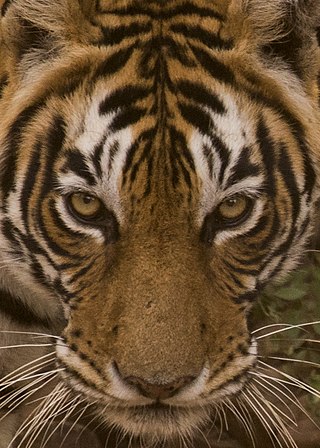
Edward James Corbett was an Indian-born British hunter, tracker, naturalist and author. He was frequently called upon by the Government of the United Provinces of Agra and Oudh to kill man-eating tigers and leopards that were attacking people in the nearby villages of the Kumaon and Garhwal Divisions. He recounted his hunts and experiences in books like Man-Eaters of Kumaon, which enjoyed critical acclaim and commercial success. He was also an avid photographer and spoke out for the need to protect India's wildlife from extermination.

Seraikela-Kharsawan district or Saraikella and Kharaswan district is one of the twenty-four districts of Jharkhand state in eastern India. Seraikela town is the district headquarters of Saraikela Kharsawan district. The district is well known for Seraikela Chhau, one of the three distinctive styles of the chhau dance. This district was carved out from West Singhbhum district in 2001. The district was formed from the princely states of Seraikela and Kharaswan, after the independence of India.

Sidhi District is one of the tribal districts of Madhya Pradesh state of India. The town of Sidhi is the district headquarters. The district is part of Rewa Division.

Korea State, currently spelt as Koriya, was a princely state of the British Empire of India. After Indian independence in 1947, the ruler of Korea acceded to the Union of India on 1 January 1948, and Koriya was made part of Surguja District of Central Provinces and Berar province. In January 1950, "Central Provinces and Berar" province was renamed Madhya Pradesh state. After November 2000, Korea and the former princely state of Changbhakar became Koriya district of Chhattisgarh state.

Rewa State, also known as Rewah, was a Rajput princely state of India, surrounding its eponymous capital, the town of Rewa.

Tigers in India constitute more than 70% of the global population of tigers. Tigers have been officially adopted as the National Animal of India on recommendation of the National Board for Wildlife since April 1973. In popular local languages, tigers are called baagh, puli or sher. The Bengal Tiger is the species found all across the country except Thar desert region, Ladakh, Jammu and Kashmir, Punjab and Kutch region. These can attain the largest body size among all the Felidae, and therefore are called Royal Bengal Tigers. Skin hides measuring up to 4 meters are recorded. The body length measured from its nose to the tip of the tail can reach up to 3 meters and it can weigh up to 280 kilograms, with males being heavier than females. Their average life expectancy is about 15 years. However, they are known to survive for up to 20 years in wild. They are solitary and territorial. Tigers in India usually hunt chital, sambar, barasingha, wild buffalo nilgai and gaur and other animals such as the wild pig for prey and sometimes even other predators like leopards and bears. There are instances of Elephant calves hunted by tigers.

Changbhakar State, also known as Chang Bhakar, was one of the princely states of British Empire in India in the Chhattisgarh States Agency. It included 117 villages and had an area of 2,330 square kilometres (899 sq mi) with a 1941 population of 21,266 people. Bharatpur was the capital of the princely state.
A man-eater is an individual animal or being that preys on humans as a pattern of hunting behavior. This does not include the scavenging of corpses, a single attack born of opportunity or desperate hunger, or the incidental eating of a human that the animal has killed in self-defense. However, all three cases may habituate an animal to eating human flesh or to attacking humans, and may foster the development of man-eating behavior.

Tiger attacks are a form of human–wildlife conflict which have killed more humans than attacks by any of the other big cats, with the majority of these attacks occurring in Bangladesh, India, Nepal and Southeast Asia.

Patna State was a princely state in the Eastern States Agency of India during the British Raj. It had its capital at Balangir. Its area was 6,503 km2 (2,511 sq mi).

Cheetah reintroduction in India is a programme initiated by Government of India to re-introduce cheetahs to India after they became locally extinct more than 70 years ago. The Asiatic cheetah whose range once included most of India were driven to extinction locally with the last known sightings recorded in early 1950s.

Alirajpur State was formerly a princely state of India, administratively under the Bhopawar Agency subdivision of the Central India Agency. The state covered an area of 2165 square kilometres, with a population of 50,185 in 1901 and its capital at Alirajpur. The average revenue of the state was Rs.100,000 in 1901.

Paan Singh Tomar was an Indian soldier, athlete, and later, Baaghi (rebel/outlaw).

Leopard attacks are attacks inflicted upon humans, other leopards and other animals by the leopard. The frequency of leopard attacks on humans varies by geographical region and historical period. Despite the leopard's extensive range from sub-Saharan Africa to Southeast Asia, attacks are regularly reported only in India and Nepal. Among the five "big cats", leopards are less likely to become man-eaters—only jaguars and snow leopards have a less fearsome reputation. However, leopards are established predators of non-human primates, sometimes preying on species as large as the western lowland gorilla. Other primates may make up 80% of the leopard's diet. While leopards generally avoid humans, they tolerate proximity to humans better than lions and tigers, and often come into conflict with humans when raiding livestock.

The Chhota Udaipur State or 'Princely State of Chhota Udaipur', was a princely state with its capital in Chhota Udaipur during the era of British India. The last ruler of Chhota Udaipur State signed the accession to join the Indian Union in 1948. Chhota Udaipur shares a history with Devgadh Baria and Rajpipla as one of the three princely states of eastern Gujarat.

Kalahandi State, also known as Karond State, was one of the princely states of India during the period of the British Raj. It was recognized as a state in 1874 and had its capital in Bhawanipatna. Its last ruler signed the accession to the Indian Union on 1 January 1948. The present titular head of the state is Anant Pratap Deo who resides in the Kalahandi Palace in Bhawanipatna

Udaipur State was one of the princely states of India during the period of the British Raj. The town of Dharamjaigarh was the former state's capital.

Surguja State was one of the main princely states of Central India during the period of the British Raj, even though it was not entitled to any gun salute. Formerly it was placed under the Central India Agency, but in 1905 it was transferred to the Eastern States Agency.

















